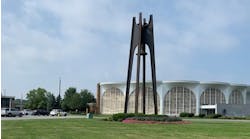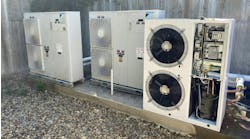By Steve Spaulding
of Contractor's Staff
DUBUQUE, IOWA — The Dubuque Telegraph-Herald has been publishing since 1850 to a readership in Iowa, Illinois and Wisconsin. Because the news never sleeps, the building gets a lot of use, at all hours and in all seasons, including harsh Midwestern winters. Keeping fuel costs under control has been a priority since the energy crunch of the 1970s.
Over the past 30 years, the Telegraph-Herald has replaced its heating and cooling equipment piece by piece to make the three-story, 82,000-sq.-ft. building more energy efficient. "We are constantly seeking ways to reduce expenses, especially for utilities," said Judd Briggs, the paper's building manger.
The drive toward greater efficiency eventually led Briggs to Dubuque Plumbing and Heating.
"We had installed a new heating system for a local church," explained John Fothergill, project manager for Dubuque Plumbing and Heating. "They were saving a ton of money as a result. Judd at the Telegraph-Herald knew some of the people on the board of the church, and apparently through conversations with them he got interested and contacted us."
Dubuque Plumbing and Heating is a 15-year-old business employing from 18 to 25 workers, depending on the season. It's a union shop, associated with Local No. 125 out of Cedar Rapids, Iowa.
Fothergill — who has been with the company since 1998 — was the contact who went down and discussed what the new system might look like.
"Judd had much of the layout done as far as the load on the building," Fothergill said. "We just went from there."
It was clear to everyone involvedthat a more efficient system meant the old boilers had to go. Since the 1950s the building had been heated by three gigantic Kewanee steam boilers.
"The newest was dated from 1956," said Mike Kelly, the rep for the job's supplier, Republic Cos. The boilers were well past their best days, routinely firing to their full capacity of 3 million Btuh, regardless of how much heat the building's occupants actually needed.
Removing just one of the old boilers proved a major undertaking.
"There was quite a lot of demo to do," Fothergill said. "There was just no way to pull them out whole. Everything had to be cut up and hauled out ... it took probably a month."
Dubuque Plumbing and Heating replaced the old boilers with four Munchkin 399 boilers from Heat Transfer Products. The high-efficiency condensing boilers boast a 95% AFUE, with load-matching to assure that the amount of gas burned is proportionate to the amount of heat needed.
"They're all hooked up in reverse-return," Fothergill said. "We're running the system temperature off the outdoor temperature, so if it's 40° or 50° F, they might only be running 140° water. As the temperature drops the water temp goes up."
So at 50° or 55° only one of the boilers might be running. As the temperature drops and one boiler can't keep up, then the next boiler comes on. To keep one boiler from running constantly the system has a built-in lead-lag.
To ensure that the system runs smoothly, it uses the Vision 3 panel board, also from Heat Transfer Products.
"It senses supply temperature on the main, and it senses outdoor temperature, and it calculates what temperature the boiler should be on," Fothergill said. "It also stages the boiler, what boiler is running, what degree of modulation, that sort of thing."
Delivering the heat to the building's original fan coil units and baseboard radiators are a series of Bell & Gossett base-mounted pumps. The building was divided into four zones for heating purposes, and then pumped primarysecondary.
"We have one main loop," Fothergill explained, "and each zone picks off the main loop pump and then pumps it to that zone and then back to the return."
All told the job took nearly three months, finishing in November 2005. Briggs has kept records of energy consumption for the two years prior and the two years since the installation, and estimates the gas-consumption savings at nearly 49%.
To say nothing of what the Telegraph-Herald is saving on space.
"Where the one old boiler used to sit we now have four boilers and all the system pumps," Fothergill said. The other old boilers are still just sitting there.
"They'll have a lot of added space down there," Fothergill said, "if they can ever get them out."

